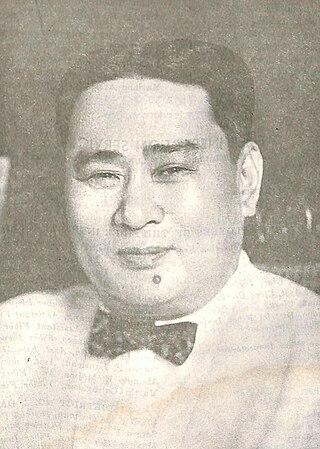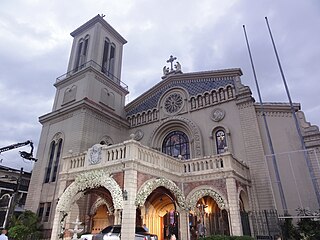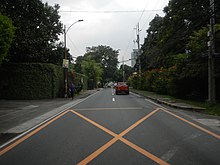
Quezon City, also known as the City of Quezon and Q.C., is the most populous city in the Philippines. According to the 2020 census, it has a population of 2,960,048 people. It was founded on October 12, 1939, and was named after Manuel L. Quezon, the second president of the Philippines.

España Boulevard is an eight–lane major thoroughfare in Manila, the capital city of the Philippines, named after Spain, the country that formerly held the Philippines as an overseas territory. True to its name, several Spanish names abound the street. It starts at the Welcome Rotonda near the boundary of Quezon City and Manila and ends with a Y-intersection with Lerma and Nicanor Reyes Streets in Manila.

Eulogio "Amang" Adona Rodriguez Sr. was a Filipino politician who twice served as President of the Senate of the Philippines. He was known for vehemently confronting corruption during the administration of Carlos P. Garcia, alleging he held a list of corrupt officials close to the president which the media dubbed the "White Paper".

Cubao Cathedral, formally known as the Immaculate Conception Cathedral of Cubao, is a Roman Catholic cathedral located in Quezon City, Metro Manila, the Philippines. It is the episcopal seat of the Roman Catholic Bishop of Cubao. Built in 1950 by the Society of the Divine Word (SVD), it belonged to the order until 1990, when the Archdiocese of Manila took over its administration. In 2003, when the Diocese of Cubao was erected, the parish was elevated into the status of cathedral. The present rector of the cathedral is Dennis S. Soriano.

Circumferential Road 3 (C-3), informally known as the C-3 Road, is a network of roads and bridges that all together form the third beltway of Metro Manila in the Philippines. Spanning some 14.93 kilometers (9.28 mi), it connects the cities of Caloocan, Makati, Navotas, Pasay, Quezon City, and San Juan.

Gilmore Avenue, formerly known as Gilmore Street, is a two-lane, one-way road in Quezon City, Metro Manila, the Philippines. It runs one-way from Eulogio Rodriguez Sr. Avenue in New Manila and terminates at Nicanor Domingo Street in Valencia, continuing on as the two-way Granada Street until it reaches the city border with San Juan, where it becomes Ortigas Avenue.

The San Juan River is one of the main river systems in Metro Manila, Philippines, and is a major tributary of the Pasig River. It begins near La Mesa Dam as the San Francisco del Monte River, which officially takes the name San Juan River when it meets with Mariblo Creek in Quezon City. As the San Juan River, it passes through Quezon City, San Juan, the Manila district of Santa Mesa and Santa Ana, and Mandaluyong.

The balete tree are several species of trees in the Philippines from the genus Ficus, which are broadly referred to as balete in the local language. A number of these are strangler figs, as they germinate upon other trees, before entrapping their host tree entirely and eventually killing it. Consequently the young plants are hemiepiphytes, i.e. epiphytes or air plants that grow several hanging roots which eventually touch the ground and take root. Some baletes produce natural rubber of an inferior quality. The Indian rubber tree, F. elastica, was formerly cultivated to some extent for rubber. Some of the species like tangisang-bayawak or Ficus variegata are large and could probably be utilized for match wood. The wood of Ficus species are soft, light, and of inferior quality, and the trees usually have ill-formed, short boles.

Ortigas Avenue is a 12.1 km (7.5 mi) highway running from eastern Metro Manila to western Rizal in the Philippines. It is one of the busiest highways in Metro Manila, serving as the main thoroughfare of the metro's east–west corridor, catering mainly to the traffic to and from Rizal.

Aurora Boulevard is a four-to-ten lane major thoroughfare in Quezon City and San Juan in Metro Manila, Philippines. It was named after Doña Aurora Quezon, the consort of Commonwealth President Manuel Luis Quezon. It is one of the major roads in the commercial district of Araneta City in Cubao. Line 2 follows the alignment of the boulevard.

Gregorio Araneta Avenue is a suburban arterial road in the Santa Mesa Heights area of Quezon City, northeastern Metro Manila, Philippines. Built in 1985, it is a 6- to 8-lane divided avenue designated as part of Circumferential Road 3 (C-3) and a physical continuation of Sergeant Rivera Street which travels from Santo Domingo Avenue at its north end near Balintawak in Quezon City, and meets N. Domingo Street in the south in San Juan near the border with Santa Mesa, Manila. En route, it intersects with Del Monte Avenue, Quezon Avenue, Eulogio Rodriguez Sr. Avenue and Magsaysay-Aurora Boulevard passing through barangays Balingasa, Manresa, Masambong, Sienna, Santo Domingo, Talayan, Tatalon, Santol, and Doña Imelda in Quezon City and Progreso in San Juan.

The Welcome Rotonda, officially Mabuhay Rotonda, is a roundabout in Quezon City in the Philippines. It is located a few meters from Quezon City's border with Manila, at the intersection of E. Rodriguez, Sr. Boulevard, Mayon Street, Quezon Avenue, Nicanor Ramirez Street, and España Boulevard. It may also refer to the monument situated on its central island.

Betty Go-Belmonte Street is a street running through the New Manila district of Quezon City, Philippines. It is a notable road in a generally northwest-southeast orientation between the junction with E. Rodriguez Sr. Avenue in New Manila and the junction with N. Domingo Street also in New Manila. It is served by Betty Go-Belmonte station of the Manila Line 2.

Tomas Morato Avenue is a street located in Quezon City within the Diliman and New Manila areas of northeastern Metro Manila, Philippines. The street links Eulogio Rodriguez Sr. Avenue in the village of Mariana in the south with Eugenio Lopez Drive in South Triangle in the north, and passes through Barangays Sacred Heart, Laging Handa, Kamuning, Obrero, and Kristong Hari. It was named after the first mayor of Quezon City.

The following is an alphabetical list of articles related to the Philippine capital region of Metro Manila.
National Route 170 (N170) is a national secondary road of the Philippine highway network. It passes through the northern part of Metro Manila, traversing through the cities of Quezon City, Manila, and Pasay.

Mariana, is an administrative division in eastern Metro Manila, the Philippines. It is an urban barangay in Quezon City in a middle class residential and commercial area known as New Manila, which includes Barangay Mariana and the adjacent Barangay Damayang Lagi.


















